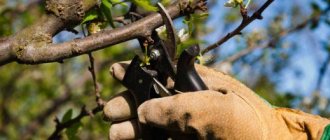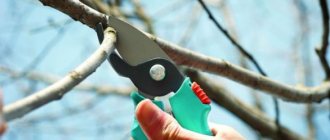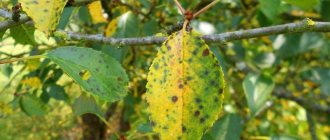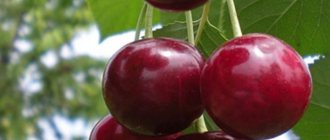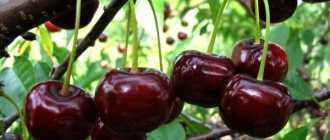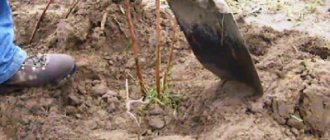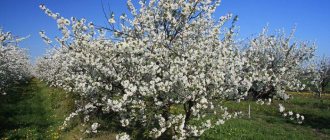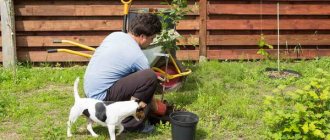Features of autumn planting
Most gardeners prefer to plant seedlings in the spring, but there are circumstances in which autumn planting is much more effective and safer. Seedlings planted in autumn have more time to take root compared to spring planting.
Why is it better to plant cherry seedlings in the fall:
- No risks typical for spring planting. In the spring, the seedling is exposed to a complex influence of unfavorable factors - it can be attacked by recurrent frosts, and also suffers from sudden temperature changes.
- Minimal exposure to negative natural factors. If the seedling is planted correctly, then it will experience a period with optimal temperature conditions. During the time remaining before frost, the trees have time to take root.
- High-quality healing of wounds received during planting. The seedling is pruned immediately before planting. During the period of rest, which lasts until spring, all wounds will heal.
- Trees planted in spring are ahead of development. In “autumn” seedlings, the root system has time to develop well, and when spring comes, the tree begins to rapidly increase its vegetative mass.
- Planting material is of better quality than in spring. In nurseries, seedlings are dug up in the fall, and those that are not sold immediately are stored until spring. Seedlings purchased in the spring are inferior in strength and viability to those in the autumn. Although they were stored correctly, they were still subjected to stress, which disrupted their natural development.
- By looking at the fresh root system, it is easy to determine the health status of the seedling.
- Autumn planting is easier than spring planting. It is enough to plant a tree and cover it - you don’t have to do anything else. Watering, weeding, treating with fungicides, fertilizing - all these are spring activities.
The main condition for autumn planting is that there should be a month to a month and a half left before the onset of persistent cold weather.
Risks when planting seedlings in autumn:
- Possibility of freezing of roots and the entire tree during severe winter frosts.
- In winter, seedlings are threatened by icing, heavy snowfall and squally winds.
- Damage to bark by rodents.
Correct disembarkation times
The timing of planting cherries depends on the climate in a particular region. There are several general rules, the observance of which will allow you to grow healthy and strong trees:
- Cherries are planted 2-3 weeks before the first frost so that the roots have time to take root. If you neglect this rule, the roots will be weak due to constant freezing and thawing;
- in the Moscow region and other regions of the central zone, trees are planted after all the leaves have fallen. The planting season lasts until the second half of October;
- in the south, cherries are planted in early October. The landing season lasts until November 10-15.
Attention!
In the Urals and northern regions, cherries are planted only in spring.
An exception is also made for trees with a weak level of frost resistance. They are also planted in spring. If the gardener missed the favorable autumn dates, planting is postponed until spring. The seedlings are stored in a trench, placing them in the hole at an angle of 30 degrees. The root system and root collar are covered with earth. The shoots must be bent to the ground and secured with a weight.
Recommended timing
The timing of planting cherry seedlings is selected taking into account:
- features of the local climate;
- average temperatures in the region;
- long-term observations of the nature of autumn weather.
Knowing, or rather, assuming the possible date of frost, count 20, or better yet 30 days from it - this is the optimal planting time.
Optimal temperatures for seedlings:
- daytime – from +10 to +15 °С;
- night – from 0 to +2 °С.
A contraindication to autumn planting is the late date for purchasing seedlings - if they do not have time to take root, they will either die or become weakened, low-yielding trees in the future. If you cannot meet the deadline, it is better to bury the seedlings in the ground until spring.
Is it possible to plant cherries in the fall? Advantages and disadvantages of autumn planting
Cherries can be planted both in spring and autumn. Spring planting is good because over the summer the seedling takes root and gets used to the new planting location. Autumn planting of cherry seedlings is permissible if it is done in advance, before the onset of cold weather and frosts.
It takes time for cherry seedlings to take root and strengthen before the onset of cold weather. Therefore, the planting time should be calculated and work should be done about a month before frost.
The advantages of planting cherries in the fall are the following:
- in autumn, seedlings actively strengthen the root system;
- the tree does not waste energy on the growth of the above-ground parts (branches, leaves);
- the period of autumn rains helps to strengthen the seedling and get used to the new place.
The disadvantage of planting cherry trees in autumn is the imminent onset of cold weather. If the planting date is not met and the seedling is planted late, it may die from frost, as it will not have time to take root and establish itself in a new place.
Landing requirements
Cherries have difficulty being transplanted from place to place. They are demanding on soils, lighting and other conditions. Before starting work, the gardener carefully selects a place where the tree will feel comfortable. Under favorable circumstances, cherries bear fruit for 15-25 years.
Landing location
When choosing a site for planting cherries, take into account, first of all, lighting and protection from the wind. Characteristics of a site suitable for planting cherry seedlings:
- Good sunlight. Lack of shadow from neighboring plantings. The best option is a gentle southern or southwestern slope. The sun should illuminate the tree from morning until the afternoon - at least, and better yet, until the evening.
- The presence of a barrier nearby, such as a fence. The barrier should be located on the north side to protect the tree from cold winds. Otherwise, the risk of flowers freezing increases.
Conditions unsuitable for cherries:
- close occurrence of groundwater - less than 1.5 m;
- waterlogged and swampy lowlands;
- acidic peat bogs;
- close proximity to oak, linden, spruce, birch, pine, apple, tobacco, and raspberry trees.
The soil
It is not recommended to plant cherries on low-quality, low-nutrient and waste soils. Before planting the seedling, the top fertile layer of soil is carefully developed - its thickness should be at least 20 cm.
Cherries grow and bear fruit best on chernozems, sandy loams and loams that have a neutral reaction. But before preparing the soil for planting, they will find out what conditions a particular cherry variety requires.
Features of soil preparation for planting cherries:
- Acidic peaty soils are definitely not suitable - you have to replace the entire top fertile layer.
- To neutralize the acidity of the soil, dolomite flour or wood ash is added to it.
- Weeds interfere with the root system of cherries, so before planting, the soil is carefully dug up - more than once, and while digging, the roots of weeds are removed from the ground.
- When digging up the area, add compost, manure or mineral fertilizers. Manure/compost is applied at 8-10 kg per 1 sq. m, superphosphate – 60 g, potassium chloride – 30 g.
Planting cherry seedlings in the fall with an open root system
It is better to prepare the hole in advance so that the soil settles by the time of planting. The size of the hole depends on the fertility of the soil. If the soil is infertile, make the hole diameter 80 cm and depth 50-60 cm. This is necessary so that there is space left to fill with fertile soil. If the soil is fertile, especially if it is black soil, the hole can be 60 cm in diameter and 40-50 cm deep.
When digging a hole, tip the top fertile layer to one side, and the bottom (infertile with sand) to the other, it is not needed. Then mix the top fertile layer with humus in a 1:1 ratio, add 0.5 wood ash, mix everything and pour it into the hole.
We make a mound at the bottom of the hole and place a seedling on it. We straighten the roots so that they hang over the mound and do not bend. Cover the roots with the fertile mixture and water with water, about 0.5 buckets per hole.
After this, we fill it completely with fertile soil so that the root collar is at ground level. There is no need to bury it, otherwise the cherry will sprout. After this, compact the soil and then mulch with humus or compost. After this, water the seedling again with water.
To prevent the tree from swaying in the wind, place a peg when planting in the hole, but so that the seedling is on the north side.
For the winter, cover the young tree with a layer of soil of 25-30 cm; in the spring, the soil will need to be removed.
Preparatory activities
When the site has been selected and prepared, they move on to the next stage - preparing seedlings and a hole for planting.
Selection and preparation of seedlings
Cherry varieties are often self-sterile, so in order for the trees to fully bear fruit, at least three seedlings of different varieties are purchased. Combined planting of self-fertile cherries is also recommended - it increases the yield of trees significantly.
Before choosing a seedling, you need to familiarize yourself with the best varieties of cherries. You can read about popular varieties here.
Rules for choosing seedlings:
- Seedlings must be healthy, without damage to the bark and root system.
- The best seedlings are one-year-olds with a height of 0.7-0.8 m or two-year-olds with a height of 1.1-1.2 m.
- Developed root system – from 25 cm in length.
- A height of more than 1.2 m indicates overfeeding the plant with nitrogen - such seedlings have reduced winter hardiness. It is better not to plant such trees before winter - they will die.
- Self-rooted seedlings are considered more winter-hardy. It is better to plant grafted seedlings in the spring.
Before planting a seedling in a hole, its roots are straightened, long ones are trimmed and dipped in manure-clay mash. Leaves are torn off to prevent moisture evaporation. The survival rate of seedlings is also increased by soaking in a solution of heteroauxin (an organic growth stimulant).
Pit preparation
The hole for the cherry tree is prepared taking into account the size of the root system. Usually a recess of 60x60x60 cm is dug. Planting holes are prepared two weeks in advance. The layout of the pits depends on the type of plant.
Prepare the soil mixture in advance. When digging a hole, the top layer of soil is set aside to mix with fertilizers:
- humus - a bucket;
- superphosphate – 200 g;
- potassium sulfate – 30 g.
If the soils are heavy, add an additional couple of buckets of river sand. Drainage is made at the bottom of the recess - you can, for example, use expanded clay. The prepared soil mixture is poured into the hole so that it takes up a third of the space. The poured mixture is lightly tamped.
When planting cherries and other fruit trees, it is prohibited to apply nitrogen fertilizers - they impair rooting. Chicken manure contains a lot of nitrogen.
Possible problems
Beginning gardeners often make mistakes that harm cherries and affect their growth and productivity. Main disadvantages:
- The planting hole is not prepared in advance, so the root collar goes deep underground, which impairs the growth of the tree.
- They apply a large amount of fertilizer, which has a bad effect on the root system.
- They buy a seedling that is older than three years, because of this, the cherry takes longer to adapt to a new place.
- Trees are planted at the wrong time, which becomes a common cause of death.
- They purchase seedlings from hand, and not from nurseries, where quality is guaranteed.
Diseases, pests
| Pest/disease | Problem | Elimination method |
| Clusterosporiasis | Numerous holes and round brown spots on the leaves. | Diseased leaves and infected parts of the cherry are removed. Then use a solution of copper oxychloride or cupritox. |
| Coccomycosis | Small bright red and pale spots on the leaves, pink spores appear below. Afterwards the leaves turn yellow and fall off. | The leaves are destroyed and the soil near the trunk is dug up. The wood is treated with copper oxychloride. |
| Moniliosis | A spot appears on almost every fruit, which over time fills it entirely. The tree loses its entire harvest. | The affected parts of the cherry are collected and removed. Then use Bordeaux mixture. |
| Rust | The leaves become covered with rusty spots and fall off. | The affected parts of the tree are collected and burned away. |
| Scab | Huge dark spots appear on the inside of the leaf, then they turn brown and dry out. | The leaves are burned, then the tree is sprayed with Cuprosan. |
| Cherry sawflies | Destroy all leaves down to the veins. | Trichogammas (natural enemies of the egg-eating sawflies) are released and treated with Piriton. |
| Cherry weevil | A green beetle that eats cherry leaves and buds. | Actelik and Rovikurt are used. |
| Aphid | Sucks sap from tree tissue. The leaves are wrapped in a tube. | Spray with chemicals such as Rovikurt or tobacco tincture with added soap. |
| Plum moth | The butterfly lays eggs in green fruits. The berries spoil. | Treated with benzophosphate and carbophosphate. |
Landing technology
Step-by-step instructions for planting a cherry seedling:
- Place a stake approximately 2 m long into the hole. Place it closer to the north side.
- Form a mound from the soil mixture in the hole.
- Lower the seedling into the hole, distributing the roots evenly over the tubercle.
- Cover the roots with the remaining soil and compact it. Form a circle near the trunk, forming a side along its edge.
- Water the seedling with warm water - 2-3 buckets will be enough.
The seedling is buried to the optimal depth, which is determined by the location of the root collar. The latter should be 3-5 cm from the ground surface. When the ground settles, the root collar will be at soil level. If after watering and settling the soil the neck is not in place, it is corrected.
If you deepen the root system of a seedling, it will develop poorly. If the roots are too close to the surface, they risk freezing in winter.
How to choose cherry seedlings for planting in the fall, including bush cherries
You should approach the choice of seedling responsibly. It must be purchased before planting. It is advisable to buy cherry seedlings in nurseries, where they sell only high-quality and good varieties. The cherry variety must be selected in accordance with the recommendations for the place of cultivation. The criterion to pay attention to is resistance to cold.
Cherry trees intended for planting should be purchased as one or two years old. The tree must have a healthy appearance. The bark of a healthy tree is brown or green, and the shoots are mature. The root system must be developed, the roots themselves must be elastic and strong.
You need to pay attention to the grafting site, where the scion and rootstock are connected. If it is present, the seedling is varietal and not wild.
Planting patterns for different varieties of cherries
The planting scheme for cherries depends on the type of plant, its height and spreading of the crown. Usually cherries are not planted alone - pollinating cherries are located nearby. The first thing a gardener has to decide is at what distance from each other to plant the seedlings.
Recommended planting patterns for cherry seedlings (distance between trees x distance between rows):
- bushy cherries - 2x2 m;
- low-growing tree-like cherries - 2x3 m.
- tall tree-like cherries - 3x3 m or 3.5x3.5 m.
To obtain good harvests, it is recommended to plant 2-3 varieties at the same time, blooming at the same time - so that mutual pollination occurs. The optimal arrangement of seedlings is in a checkerboard pattern.
How to plant cherries in the fall: step-by-step instructions
Choosing a landing site
The area for planting cherry seedlings should be chosen as open and well-lit. Winds and drafts are contraindicated for cherries , so cherries can be planted near a house, fence or any other building. The site should be viewed from the south or southwest side of the garden. The sun's rays should illuminate the tree most of the day, since cherries are heat-loving fruit crops.
Lowland is not a place to plant cherry trees. Wetlands or places with high groundwater levels are also not suitable. Too much moisture contributes to rotting of the neck and rhizome. If the groundwater level is above one and a half meters, you need to make an artificial elevation for planting seedlings.
The proximity of a cherry tree to an apple or hazel tree is undesirable. Tall trees will not allow cherries to grow and bear fruit well. However, cherries require cross-pollination . Therefore, we need more cherry trees next to it. The distance between them is at least 3 meters.
Most often, gardeners tend to plant tree-like cherry trees. They grow up to 6 meters in height. Fruiting of such varieties begins in the fifth or sixth year after planting.
Bush cherries grow up to 4 meters in height, and berries appear on them 4 and 5 years after planting.
When planting tree-like cherries, you need to maintain a distance in rows of at least 4 meters, and plant seedlings no closer than 3 meters from each other.
The distance between bushy cherries can be reduced by 1.5 times.
Preparing the planting hole
The planting pit is prepared in advance. If it is possible to do this at least 14 days before planting, this is good. If this is not possible, then digging a hole on the day of planting is allowed.
The first layer of soil, which is removed when digging a hole, is set aside - it will be needed for subsequent work.
The dimensions of the planting hole for a cherry seedling with an open root system should be 0.6x06 m. If a seedling with closed roots is planted, you should simply dig a hole that is twice the root volume.
The bottom of the hole must be lined with expanded clay or broken bricks so that moisture does not stagnate and the roots of the seedling do not rot . If the soil is acidic, you can add chalk or limestone to reduce the acidity. The nutrient mixture is already laid out on it (read how to prepare it above).
Soil preparation (adding fertilizers, etc.)
It is recommended to grow cherries on loamy and sandy loam soils. Suitable for growing black soil. You should choose soil that is neutral in acidity and loose, which can allow air and moisture to pass through. Sandy and clay soil is not suitable for planting cherries, so it is better to dilute such compositions and bring them to a neutral acidity level from 7.5.
Sandy soil is diluted with clay and compost, and clay soil with sand.
The nutrient mixture is laid on top of the drainage, and a mound is made from it if necessary. Do not use fresh manure to fertilize the planting hole. It can burn the root system of the seedling. Humus, peat, compost are acceptable options for feeding the rhizome of a seedling.
Proper planting of cherries:
Preparation of seedlings
Seedlings should be inspected and prepared for planting in advance . If the roots dry out, the tree must be kept in water for a day. If the roots are elastic and moist, the seedlings are dipped in a weak solution of potassium permanganate for 30 minutes to disinfect. The bark of the seedling should be intact and smooth. The cervix should also not be damaged.
Cherry planting process
After the planting hole is completely ready, you need to make a small mound and install the bare-rooted tree on it.
If a seedling with a closed root system is planted, there is no need to make elevations. It sinks into the ground as is, entirely.
A wooden stake is placed nearby in the center of the hole, to which, after burial, the cherry trunk will be tied. The height of the peg should be slightly higher than the height of the seedling.
The roots of the seedling should be directed downwards when planting. They begin to be covered with a nutrient mixture, periodically using compaction. All inter-root voids must be filled with soil. If the seedling has a graft, it should be left 5 cm above ground level. The neck cannot be buried, otherwise the tree will die.
After the seedling is firmly planted, the soil is compacted, watered with two buckets of water and added again if necessary. The top layer can be made from the soil left in the planting hole. The tree is tied to a stake and covered with mulch.
Cherry planting:
Care after landing
The process of autumn planting itself is not complicated, and you don’t have to think about care until spring. After autumn planting, gardeners have only one agrotechnical measure left to perform - insulating the seedling.
In order for the seedling to winter safely, it is protected from frost, snowstorms and rodents. Procedure:
- Watering the tree. The norm is 5 l. When cold weather sets in, the hole near the trunk is filled up so that melt water does not stagnate in it in winter.
- Immediately before the frost - a month and a half after planting, the seedling is hilled up, raking up an additional layer of soil of 30-35 cm. Even better - mulch the soil with sawdust, humus or peat.
- The top is additionally covered with spruce branches, reeds or other breathable material. The created protection will save the seedling from both cold and damping off. In spring, the protective layer is removed and the soil near the base of the tree is leveled.
All other activities for caring for the seedling are postponed until spring. With the onset of warmth, the tree is pruned, watered, treated with fungicides, and loosened.
What care is needed for young trees?
When the cherry tree begins to bear fruit, it should be fed annually.
Young cherries planted in the fall do not require special care - they need more rest and time to take root. If the weather outside is quite warm, the trees can be watered several times, but after the onset of frost, watering should be stopped completely. Further care for cherries depends on the climate in the region and the amount of precipitation.
Central Russia, Leningrad region and Moscow region
Here the end of autumn is often rainy, and excess moisture can be detrimental to the roots. If there is a large amount of precipitation around the tree trunk, you need to make small grooves for the outflow of water. Winters often have little snow - in this case, it is necessary to shovel snow onto the trunks so that the trees can overwinter normally.
Urals and northern regions
Young cherries should be wrapped in burlap or non-woven material, and topped with spruce branches - this will help protect them from freezing.
Southern regions
In the south, no special preparation for winter is required, but it is advisable to take measures against rodents. A mixture of clay and mullein, which has a distinct unpleasant odor, will help repel pests; it should be applied in a thin layer to the tree trunk.
Timing and features of planting cherries in different regions
The timing of autumn planting of cherries is adjusted to the climatic conditions of the regions. Gardeners, first of all, take into account the time of arrival of the first frosts and persistent cold weather.
Approximate timing of planting cherry seedlings depending on the region
| Region | Optimal timing for autumn planting | Note |
| Middle zone and Moscow region | from early to mid October | Seedlings are planted when favorable temperatures are established, facilitating rapid adaptation and rooting. |
| Southern regions | from mid-October to mid-November | The plant, having gone into a dormant period, finds itself in conditions optimal for adaptation. |
| Northern regions and the Urals | beginning of September | Frosts come early here, it is important to plant seedlings on time. |
In regions with harsh winters - in the north of Russia, in Siberia, in the Urals, it is advisable to plant cherries in the spring.
We recommend reading an article about popular varieties of cherries for growing in the Moscow region.
Selection and preparation of seedlings
For autumn planting, select seedlings that have already entered the dormant period. This means that they should be without leaves and young shoots. Then the plants will use all their strength to take root.
The root system should be well developed and reach 25 cm.
One- or two-year-old trees are optimal for planting in the fall. The height of the seedlings should be no more than 100 cm, and the bark should be brown.
Attention! If the height of the seedling exceeds 100 cm or the bark has a greenish tint, it means that the plant has been “overfed” with nitrogen, and this stimulates active vegetation and reduces winter hardiness.
Selecting a location
An adult tree does not tolerate transplantation well. Therefore, before planting cherries, choose a suitable place. This should be a well-lit area on a hill, protected from wind and drafts. It is important that there are no trees nearby that will shade the cherry tree.
Cherry is sensitive to waterlogging, so swampy areas and places with close groundwater are avoided.
Reference. With proper care, cherries grow in one place for 15-20 years and bear fruit successfully.
Cherry prefers to grow on sandy and loamy soils. Soil acidity should be within normal limits. If the soil is very acidic, it is limed in advance (400 g of lime per 1 m²). This procedure is not carried out in the year the seedlings are planted.
What mistakes are made when planting cherries?
No gardener is immune from mistakes. Given the variety of planting techniques and the abundance of nuances, it’s easy to get confused. The most common mistakes:
- Purchase of large seedlings. Following such aspirations, you risk getting a problem tree. The larger the seedling, the older it is and the more difficult it is to take root. You cannot buy a seedling older than two years.
- Buying planting material for future use. Do not take seedlings in advance. If the tree does not enter a dormant period and prepare for the coming winter, it will not take root well.
- Digging up the area shortly before planting. It is advisable to do this event in advance. Ideally - in the spring. The pit is prepared no later than 2 weeks in advance - if this rule is violated, the root collar will be buried in the soil due to subsidence of the soil.
- Overdose when applying fertilizers to the planting hole. When there is an excess of mineral elements, bacteria that process fertilizers into forms accessible to plants die.
- Use of fresh manure . The decomposition of unrotted manure in the soil is accompanied by the release of carbon dioxide and ammonia, which inhibit the root system of plants.
There is nothing complicated about planting cherries in the fall - the main thing is to study the agricultural technology of the activities and correctly determine their timing. If you approach the matter correctly, then autumn planting will bear fruit - the seedling will take root safely and quickly begin to grow in the spring.
0
0
Copy link
Outdoor care
For proper growth, development and fruiting of cherries, they take care of them.
Features of watering
A bank of earth about 25 cm is poured onto the seedling around the trunk and about 2 buckets of water are slowly poured into this hole. After absorbing the moisture, mulch the ground near the tree trunk. Afterwards, water the cherries as needed.
Fertilizers
To ensure that cherries grow well in open ground, fertilizers are applied. This is not done during the first two years. And from the third year until the first flowering, nitrogen-containing fertilizers are introduced. The best option is to add fertilizer to the water. As soon as the cherry blossoms, feed it with humus and compost. In summer, any organic matter is used. In the fall, potassium-phosphorus fertilizers, for example, potassium monophosphate, are suitable.
Trimming
Prune the seedling immediately after planting. There should be 50 cm of bare trunk left from the ground to the first branch, all the rest should be cut off. Only 6 strong branches are left at an acute angle to the cherry trunk - this is the main crown of the plant. These branches are shortened by about 7 centimeters. The rest are cut to zero, down to the stump on the trunk, the cuts are lubricated with garden varnish.
The crown is formed as follows:
- They begin in early spring by cutting off the one-year-old shoot to 80 cm in height. This will be the first level of branches.
- Next year, cut off the central conductor from the highest branch to the first level by 80 cm. This will be the second tier with three branches around the circumference of the tree.
- Once the crown is formed, the cherry tree is limited in height to 2.5 meters. Frequent branches are thinned out.
Reproduction
Cutting method:
- They indicate approximately two-year-old growth near the mother tree next to strong roots.
- Do not take cuttings close to the root system, otherwise the roots of the mother tree will be damaged. Afterwards, the root connecting the shoot and the mother tree is cut off. Already in the spring this shoot is transplanted to a new place.
Seed propagation method:
- Fresh bones are dried and placed in water for several hours. Seeds that have sunk to the bottom are suitable for planting, and the floating seeds are removed.
- The first ones are placed in a container with sand and water and left until warm weather in a dry place, moisturize and weed as needed.
- They are fed a little with fertilizers (superphosphate, potassium chloride).
- For the winter, cover the seedlings with film and leave them in the cellar or any other dry place.
Selection of good seedlings
Many cherry varieties do not have the ability to self-pollinate, so you need to buy three or four seedlings. They must be of different varieties. This way, they will be able to pollinate each other, and the first fruits will appear on the trees faster. Gardeners also practice combined planting of cherry varieties capable of self-pollination. This increases productivity many times over.
When choosing a seedling, you need to focus on the following indicators:
- annual length - from 70 to 80 cm;
- length of a two-year-old - from 110 to 120 cm;
- development of the root system - from 25 cm and above;
- whole, mature wood.
You should not buy planting material that is too high. This is a sign of overfeeding with nitrogen fertilizers. Such trees can die in frost.
Advice!
If you get overgrown seedlings, it is better to plant them in the spring.
As already mentioned, there are own-root varieties of cherries that can bear fruit without the help of pollinators. However, grafted varieties enter the fruiting phase earlier.
How to prepare the soil for planting cherries in the fall
Cherries take root faster and better in nutritious and balanced soil. The site for it must first be prepared and fertilized with minerals and organic matter.
Cherry trees feel best on small hills near buildings or high fences - the latter protect the cherry from the wind. The soil for the plant is sandy or loamy, with a pH level of about 6-7. Acidic soil is not suitable for cherries; it will need to be removed by 20 cm and replaced with fertile soil.
The area for planting is prepared as follows:
- 3 weeks before planting the crop, the ground is dug up and loosened, removing all weeds and plant debris;
- When digging, fertilizers, a bucket of manure or compost and a little superphosphate and potassium salt are added to the soil.
To plant a crop in the fall, you need to immediately prepare a permanent place. Cherries do not like replanting, so it is necessary to take into account that the tree will remain in the selected area of the garden for 18-25 years.
Calendar of the main work of a gardener in caring for cherries in the Moscow region
Spring
They carry out sanitary pruning of trees, remove insulation from the trunks (if they were placed in the fall for wintering).
They inspect the tree bark, disinfect and cover up damage, and bleach the trunks and branches. If there is little moisture in the soil, watering is carried out.
Be sure to loosen the soil and also spray against diseases and insect pests.
Summer
At this time of year, it is important to inspect for insects that can harm cherries, as well as water the trees (especially if the summer has been dry). When the harvest ripens, you need to regularly pick the berries.
Autumn
Autumn work includes the mandatory removal of fallen leaves, branches, and various debris.
They carry out whitewashing of the trunks (if necessary), minor pruning, as well as preventive spraying of cherries against pests and diseases. Also in the fall, mineral fertilizers are applied (feeding can be root or foliar), and the cherries are also prepared for wintering (mulching, insulation).
Caring for a fruit tree is not so difficult, especially if you do it all with the desire and desire to get a harvest. Well, cherries will not remain in debt and will definitely delight you with ripe berries! So - good luck!
Selecting the landing time
Let's decide now when and how to plant cherries in the Moscow region? The optimal time is spring, but at the same time we choose a moment so that the buds have not yet begun to bloom (in this region this is until the first ten days of April).
Autumn planting is also possible, but there is an exact guideline - no later than the beginning of October. Of course, you always need to look at the characteristics of a particular year, otherwise young seedlings may get frostbitten.
If cherries are purchased, and the weather does not allow planting in the fall, the seedlings should be buried. To do this, they dig a small trench, lay the seedlings there at an angle, sprinkle the roots with soil and lightly shed them. Then they cover it with spruce or pine branches, maybe sawdust, and then, when it starts snowing, sprinkle it with snow. In this condition, the seedlings will successfully overwinter and be ready for planting in the spring.
Optimal timing for planting in autumn
The exact timing of planting a tree in the fall depends on the specific region and weather conditions. It should be assumed that cherries should be planted in the ground no later than 18–22 days before the expected onset of the first frost, otherwise, under the influence of night frosts, the root system of the tree may be constantly subject to freezing and subsequent thawing. If this is not so dangerous for a rooted adult tree, then a young seedling simply will not be able to take root.
Important! The greatest dangers for seedlings during spring planting are recurrent night frosts, cold winds, and large differences in air temperatures during the day. In addition, in the spring the rest period that the tree needs for normal adaptation and development is much shorter.
If we talk about some specifics, then under typical weather conditions the approximate time frame for planting a tree in the ground is as follows:
- central Russia, northern Ukraine and all of Belarus - after the leaves fall and until the second ten days of October;
- in the south of Russia and most of Ukraine - all of October until the second ten days of November;
- Northern regions of the Russian Federation and the Urals - cherries are planted exclusively in the spring.
The variety should also be taken into account: if it does not tolerate frost well (especially in the middle zone), then it is better to plant the tree in the spring. In the event that for some reason the most favorable time for planting is missed, there is no need to rush trying to make up for lost time. In such a situation, the more correct decision would be to leave the seedlings until spring planting, properly preserving them.
This is done using the digging trench method, which is quite simple:
- Dig a trench along a west-east axis, 0.3–0.4 m wide and deep, with a sloping southern edge, the angle of elevation of which is approximately 30°, and a steep northern edge.
- Seedlings are placed in the hole (after pre-treatment) so that the roots and root collar are in the trench, after which they are covered with earth.
- The trunk and branches are lowered to the ground, covered with cut thorny branches of elderberry or rosehip (to repel rodents).
Did you know? For most people, cherries evoke strong associations with a small compact tree. However, in England there is a cherry tree that reaches a height of 13 m (this is quite a bit short of the height of a five-story building), its age
—
more than 150 years.
Preparatory work
Careful selection of location, improvement of soil properties, selection of varieties and purchase of seedlings do not relate directly to the planting itself, but seriously affect the final result. Mistakes at every stage can ruin all further efforts. And following simple rules significantly simplifies care later and brings the first harvest closer.
Selection of seedlings
When selecting material for planting, you should pay attention to varieties adapted to a given climate. Different periods of soil freezing, spring frosts, droughts or periods of rain - all local weather conditions must be taken into account. Released varieties that have performed well in a given area will be the best choice. It is advisable to purchase seedlings from nearby nurseries or from experienced gardeners.
The age of the tree also matters. One- and two-year-old seedlings are suitable for planting. Preference is given to trees with a rudimentary crown (having several skeletal branches), a trunk diameter of up to 1.5 cm, and a height of about 100 cm. Both two-year-old and one-year-old seedlings can meet these criteria. If annual plants over 1.5 meters high are offered for purchase, you should not take the risk. The trees are overfed with nitrogen for rapid growth, do not have time to ripen and may not survive the frosty winter.
Some tips for selecting based on appearance:
- there should be no leaves on the tree (especially withered green ones);
- the trunk is straight, without deviations from vertical growth;
- in grafted hybrids, the stump cut is overgrown, without overgrowth;
- the root system is developed, not overdried, without thickening or growths.
The roots of plants selected for cultivation should not be shortened. It is necessary to remove damaged ends that have become soaked during digging. The length of the developed root system of a one-year-old seedling is more than 15 cm, and that of a two-year-old seedling is more than 25 cm. To avoid losses during transportation, the roots of the seedlings are dipped in “chatter” (a mixture of clay and water) and packed in burlap or protected from drying out in any available way.
Important! Self-rooted plants tolerate cold more easily and are able to recover after the death of the above-ground parts. Grafted cherries begin to bear fruit faster, but recover less well from damage.
Right time
The timing of planting is very important, because cold weather is approaching and the plant must have time to prepare. In different regions, the terms may differ significantly, but the main criteria remain the same:
- The end of the growing season of the aboveground part of the plant. The seedlings have dropped their leaves.
- At least 30 days before the expected onset of frost.
- Soil temperature above +10 °C.
Depending on the climate, the right moment may occur between August and the end of October. Knowing the date of expected frost and counting 30 days from it, the best planting date is obtained. By this time, several weeks are added for processing and shrinkage of the soil.
If all conditions are met, then the upper part of the plant remains at rest, and the underground has the opportunity to actively develop. In a month, the cherry tree manages to grow enough roots and the seedling “takes root” in a new place. If weather conditions have changed dramatically, a cold snap is coming and there is no time to plant trees, it is worth postponing planting until spring. In this case, the seedlings are buried in a shallow trench, covered with soil and left to overwinter.
Good place
Cherry trees love the sun. When looking for a place in the garden, make sure that the seedlings are well lit. When planting along hedges and fences, choose only the sunny side. Neighborhood with apple trees, pine trees, and other shading trees is also possible only from the south. Cherries tolerate close planting with each other – up to 2 m between plants.
Cherries planted in low-lying, damp places do not produce good harvests and often get sick. Plantings should be well ventilated, but strong winds in winter can destroy plants. Therefore, the cherries will be uncomfortable on the tops of the hills. Western and northwestern slopes with a slope of no more than 6% are considered ideal.
If you need to plant cherries in an already stocked garden plot, monitor the lighting and leave room for the formation of a crown based on the characteristics of the variety, but not less than 2.5 m in diameter.
Low-growing and dwarf cherry varieties require an even more careful approach to lighting. In shaded places they will not show their decorativeness and fertility to the fullest.
Laying the planting hole
Cherry is not too demanding on the composition of the soil. The plant feels bad only in areas that are too rocky, clayey or completely flooded. The best growth and fruiting are observed on light, breathable soils: chernozems, loams, forest turf, sandy loam.
Cherries do not tolerate high acidity in the area. The soil should have a slightly acidic or neutral reaction. Otherwise, it should be pre-limed: add up to 3 kg of lime (or dolomite flour) per 10 m² or add 1 kg to each planting hole.
In the best case, the site is prepared a month before planting. Dig up the area to a depth of 40 cm, simultaneously with liming and applying organic fertilizers (humus, manure). If time permits, it is advisable to sow green manure plants on the site, wait for shoots to emerge and incorporate them into the ground as fertilizer.
The holes are dug no later than 2 weeks in advance to ensure complete shrinkage of the soil. The diameter of the finished pit is from 50 to 80 cm, the depth is 60 cm. The heavier the soil, the deeper the planting site should be built. In clayey and rocky soils, a hole is dug up to 1 m and filled with separately prepared fertile soil.
When planting cherries, the finished depression is filled in layers:
- Drainage - a layer of crushed limestone.
- A mixture of soil with mineral fertilizers (superphosphate 40 g, potassium chloride 25 g).
- A fertile substrate made from equal parts of soil removed from a hole and humus (humus).
Potassium chloride can be replaced with wood ash in an amount of 0.5 kg.
Important! At this stage, nitrogen fertilizing and large doses of mineral fertilizers should not be used. This will have a bad effect on the biological composition of the soil and the survival rate of seedlings. It is unacceptable to use fresh manure; its decomposition products inhibit the root system of a young plant.
